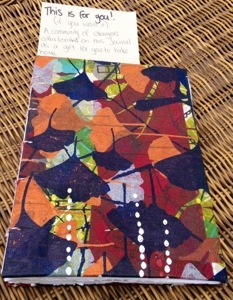Wednesday July 31
Salon, Melbourne Recital Centre
Syzygy Ensemble specialise in the performance of contemporary music. They consistently present high quality performances mostly of the sort of stuff that I like to listen to. Their shows are meticulously and academically prepared and they perform with humour and grace. This ‘Games, Riddles & Puzzles’ concert was a showcase of virtuosity, absurdity and sublimity.
This concert began with Catch (1991) by Thomas Adès, the only piece on the program that I was vaguely familiar with. It is fiendishly difficult, featuring extremes of register for the violin, cello and clarinet. The performers made it look easy. They wouldn’t have been happy with some of the ensemble but guest artist Ashley Smith on clarinet was a standout. I don’t know if the theatrical element of this performance is scored or not, but it certainly helped achieve the compositional objective. Ashley, henceforth referred to as ‘The Peacock’, paraded around like an egomaniac (complete with sparkly silver pants) before eventually being persuaded to adhere to the norm, follow the crowd, submit to convention, reject individuality and join the rest of the ensemble for a lovely sing-a-long around the piano. How sad. This piece really should have been written backwards. Maybe if Syzygy record this they could release a B-side of the backward-masked version.
I found Mirrors (1977) by Kaija Saariaho quite gimmicky. This is scored for flute and cello and consists of constantly mirrored versions of musical elements. Unfortunately I didn’t notice much of this because the breathy speaking over the flute mouthpiece reminded me of phone sex (not that I would know anything about that).
The Danish piece Die Wanderin (2007) by Neils Rønsholdt was exquisite. I could have quite happily listened to the violin scratching away at those glissandi for hours. I was told that while the previous piece was being performed that Jenny had been scrubbing ferociously at her violin strings with alcohol wipes to get the rosin off. The result was a truly mesmerising, etherial sound. The bow was just scraping across the strings with no purchase whatsoever, producing a beautifully random array of harmonics. A soundtrack of footsteps provided the beat while the piano occasionally punctuated the soundscape with cool jazz chords for extra ‘ahhh’ moments. We were told that this is supposed to be performed with an accompanying visual display, but due to lack of funding, the screen was absent. I’m glad it was. I liked the sounds and wanted them to go on forever.
Hi Bill! (2005) by Iris ter Schiphorst. Bleh. Flashy crowd pleasing number from ‘The Peacock’ on the bass clarinet. A worthwhile time to explain why ‘The Peacock’. For this little ditty Ashley wore a small peacock headdress (along with the silver sparkly pants). That’s not the main reason though. Smith is the peacock of clarinet playing. A complete show off. But he can be as arrogant and brash as he likes because he’s bloody good. He plays with wild abandon and looses little technique in the process. Hi Bill! would have been super fun to perform with all the poppy tunes and synth bass lines played with slap tonguing and multiphonics. Not so much fun to listen to. Why do audiences cheer and clap the loudest for this sort of stuff? Filler.
Architectonics VII (1992) by Erki-Sven Tüür consisted of some lovely cannon-like interplay between the bass clarinet and flute. Microtonal fluctuations caused some pretty groovy sub-harmonics in the space. As soon as that happens I forget that I’m supposed to listen to what the musicians are playing and not the resultant frequencies resonating in the room. Has any composer written a work for two instruments where the primary melody is contained in the resulting sub-harmonics? If not, there’s a commission on offer. I’ll pay by cooking you dinner.
Dust (2009) by Sean Shepherd was dusty, rusty and a little loose. Schmultzy programmatic mush appealing to the romantics in the audience. I would have rathered this work be left off the program and the conservative members of the audience be invited to get off to some Rachmaninov in the privacy of their own home.
Sounds and Shapes (2003) by Takuma Itoh was the least challenging work on the program to listen to, hence last on the bill. This was the chance for all ensemble members and guest artists to take to the stage on a rousing finale. A flashy, crowd pleasing number that was warmly and over-enthusiastically applauded. Nice, but I would have liked the show to finish with some repetitive scratchy violin.
